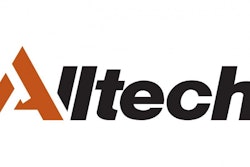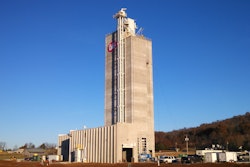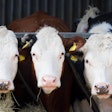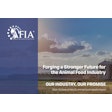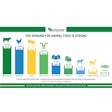During a symposium held by Alltech in 1989, Italian professor Archimede Mordenti told an audience of 300 that if animals were to survive and thrive they needed to produce food sustainably. His idea spawned Alltech’s ACE principle (Animal Consumer and Environmentally friendly), but at the time, his speech was considered controversial and many in the audience walked out.
Fast-forward 25 years, and the word sustainability is highly regarded. The agriculture industry alone has taken great strides to embrace opportunities and face the challenge of feeding 9.5 billion people globally.
Companies’ role in sustainability
“We have a certain amount of resources on this earth, and we need to be good stewards of these resources, whether we’re running a business or an educational institution,” says Giles Shih, CEO and co-founder of BioResource International (BRI).
BRI started 15 years ago out of a sustainability project to convert poultry waste into biogas energy through anaerobic digestion. At the time Shih was a recent Ph.D. graduate, and his father, Dr. Jason Shih, was a professor at North Carolina State University with six patents to his name — most notably an enzyme to help turn poultry feathers into a more digestible feather meal. “We were able to harness the natural power of this novel enzyme,” says Shih. “And from that initial discovery our company has gone on to develop innovative enzyme feed additives that help the farmer be more productive.”
The enzymes in BRI’s products help improve digestibility and feed efficiency in poultry and swine, so that more energy is focused on growth and feed nutrients are better utilized.
“Sustainability comes down to being more efficient,” Shih says. “Efficient processes will save time, money and resources.” He explains that investing in employee growth is a sustainable practice because it results in lower turnover and reduces the amount of time and money spent on the constant recruiting and training of new employees.
Another sustainable practice is to ensure that products are produced and shipped efficiently with the lowest possible carbon footprint. “Coming from a background in the life sciences definitely influences my business decisions because nature is very efficient,” Shih says. “I think that sometimes the industry has a mind-set that either you do things sustainably or you make a lot of money, but I believe that it isn’t ‘either/or’; it’s ‘and.’”
While the initial investment may be higher, Shih says the long-term results are worth it. “At the end of the day all of us in the feed industry have a mandate to help to feed the world, and do it in a way that is sustainable for future generations.” He adds, “it helps to sell to a market that appreciates that value.”
Consumers’ role in sustainability
“Everyone has a role in sustainability,” says American Feed Industry Association (AFIA) president and CEO Joel Newman, “but it takes collaboration.”
He says that aside from industries leading the movement, consumers also need to make the right choices. “Consumers want to know when they buy food products what the industry is doing,” Newman says. Educating consumers is an important part of AFIA’s sustainability initiative.
“We have a lot of people that we talk to every day that don’t know about agriculture, and don’t know what it means to give back to the community.”
Promoting the understanding of U.S. food production, and supporting the community are vital parts to AFIA’s sustainability initiative. And according to an independent survey by AFIA, the U.S. feed industry logged 46,500 hours of community service in 2013 — double the number of hours of community service in 2012.
AFIA wants consumers to know that the agriculture industry is making an effort to grow food sustainably, and to waste less.
“Another part of the initiative is looking at how to maximize our use of energy and natural resources,” says Newman. For example: “This could come down to using a boiler or energy in a plant, and how we deal with the waste.” There is also research being done by AFIA to make the nutrition consumed by animals more precise so that the animal uses the nutrition more efficiently and less is lost through animal waste.
In a joint three-year project with the Food and Agriculture Organization of the United Nations (FAO), AFIA is measuring the life cycle analysis in feed ingredients.
“This is the first project that FAO has done with a private industry,” says Newman. “When we’re done with this project, we will have a database for each of the feed ingredients used, and we’ll have a tool in place for going forward.”
Measuring efficient and environmentally safe practices
Audits conducted by a third party, such as the SCS Global Services, is another step the industry is taking to ensure that sustainably grown foods are in fact grown using sustainable practices. “Sustainably Grown is one of the most stringent certification standards,” says Dr. John Greaves, Kemin vice president of specialty crop improvement. “The certification supports long-term sustainable agricultural production by identifying crops grown in accordance with exceptional environmental and social responsibility, as well as quality and safety requirements.”
Greaves says 100% of Kemin Industries’ rosemary and mint production are certified Sustainably Grown. “Today, consumers continue to demand more plant derived products and are interested in supporting sustainable agriculture practices,” he says. “Our company’s agronomical growing practices ensure customers that its products are not just high quality, but produced in a sustainable and environmentally responsible way.”
The goal of Kemin Industries is to not only provide ingredients with active or functional benefits, but to enhance the agro-ecosystem rather than endanger it. For example: “Approximately 80% of rosemary that is used as a spice or for extraction is harvested from the wild in the Mediterranean region of southern Europe and North Africa under license from sovereign governments,” says Greaves, explaining that this alters the ecology of delicate semi-arid ecosystems and therefore produces a product that varies in quality. “The vertically integrated approach of Kemin uses the best growing practices to produce a consistent, sustainable and cost-effective supply of rosemary extract-based ingredients,” he says.
Greaves notes that a very important part of the company’s sustainability initiative is its environmental farming practices. “Kemin contracts with growers — often family farmers — in the United States and around the world to grow its specialty crops.”
This partnership increases the quality and quantity of crops, as well as improves farming practices, and promotes healthy working conditions.
Creating a cost-effective sustainable practice
Since the controversial ACE speech by Mordenti in 1989, Alltech has focused on research and applying practices that help animals get the most nutrients out of feed (energy and protein) and that as a consequence result in less excreted into the environment. The goal for this philosophy is to waste less. “The ACE principle fit with the direction that Alltech was taking,” says Alltech CIO Aidan Connolly.
Connolly says that Alltech is always future proofing, i.e., looking at what consumers are going to want next whether that be recycling, animal welfare, etc. “We’re on this treadmill where the consumer is demanding more and more — and this isn’t going to go backward with the consumer saying that enough has been done,” he says. “The idea of being sustainable and having a strategy is going to be a must for all agribusinesses. This will not be a choice.”
The goal of Alltech is to not increase costs for the consumer, but to instead help the producer be more efficient. “We have engaged a group called ECO2 to benchmark the process by evaluating how cows are fed, and the amount of greenhouse gases released, as well as evaluate the improved profitability of the farm,” Connolly says. The focus of the evaluation is to see if, and by how much, farm profitability will increase by changing the nutrition in the cow feed. Alltech also uses a series of analytical systems to see the impact of nutrition on ruminants, chickens and pigs.
Future of the sustainability movement
“We are very aware of our need to be sustainable for us and for our customers — the companies that are asking how sustainable milk, meat and eggs are produced,” says Connolly. For more than three decades, Alltech has used its ACE initiative as a guide to ensure all of their work is sustainable and has a positive impact on the animal, consumer and environment.
As a leader in the sustainability movement, Alltech takes its responsibility seriously. “According to our last global survey, there are over 28,196 feed companies in the world, producing nearly 1 billion tons of feed,” he says. “We are engaged with 95% of these feed businesses.” But, he is concerned that these breakthroughs are not receiving the recognition they deserve. “We [the agriculture industry] needs to work on communicating these successes to the public,” he stresses. “It’s critical that we all recognize and engage more with the media and general public on the successes that we’re making.”
It’s important to remember the the idea that sustainability was important — or would be necessary — was not always accepted. “We have come a long way in the sustainability movement,” says Connolly, “and we’re going to go further.” While the agriculture industry is currently efficient at producing food, Connolly believes that if the industry continues to make these changes food productivity can be improved by 70% during the next 30 years.
Subscribe to Magazine


